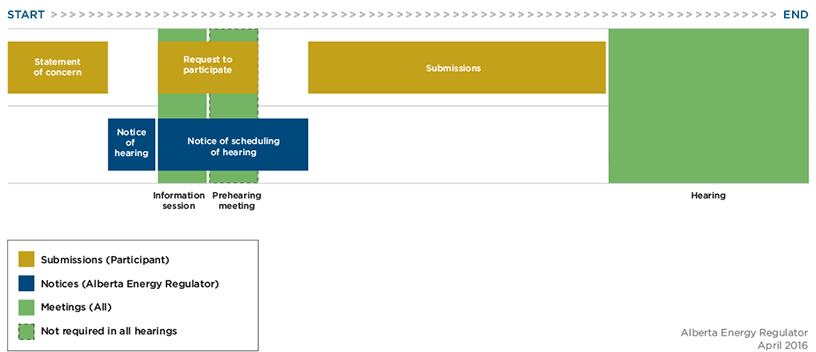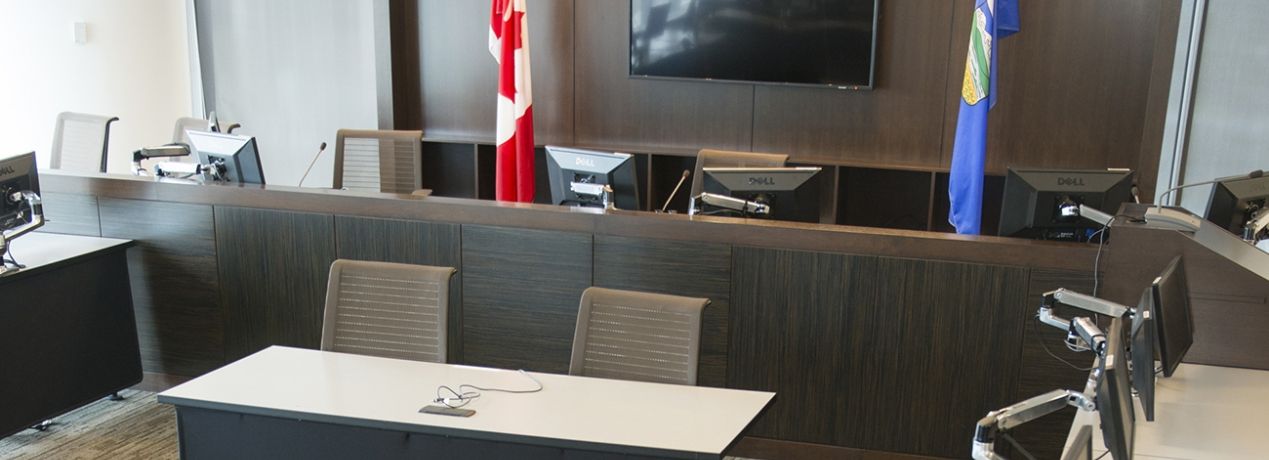An AER hearing is a formal court-like process. We use hearings to gather information before making a decision on energy applications. At a hearing,
- participants present evidence, ask questions, and make arguments about energy projects; and
- information, evidence, questions, and responses are all weighed and balanced by a panel of AER hearing commissioners, who are adjudicators with specialized knowledge in a variety of fields related to the energy industry.
We may also partner with the Impact Assessment Agency of Canada (IAAC) when both Alberta and Canada have a responsibility to make decisions on proposed energy projects.
Hearing Timelines
Although timelines vary, the following is a general guide to the typical hearing process. The actual time it takes to complete the process will be determined by the assigned hearing panel. The hearing panel considers the unique facts and circumstances to ensure a fair hearing schedule.
Part 1 of the hearing process timeline provides guidelines for the length of a few types of typical AER hearings.
Part 2 shows the order of activities for a typical hearing and approximate timelines for a hearing on a small energy project.
AER Hearing Process for Participants

(Click to view larger image - PDF)
Part 1 — Estimated Timelines for Various Types of Hearings
The following does not include alternative dispute resolution (ADR), adjournments, or the time to issue a decision report.
| Type of hearing | Estimated time to hold a hearing | Sitting time |
| Well, facility, or pipeline project with one landowner or limited issues
|
3 months (more detail in part 2 below) | 1–2 days |
| Complex project (large pipeline, oil sands development, or coal mine) with multiple participants | 4–5 months | 1–2 weeks |
| Joint hearing with Impact Assessment Agency of Canada | 1–2 years | 2–4 weeks |
| Written hearing | Highly variable; often the timeline for a written hearing is longer than for an oral hearing. | 0 |
Part 2 — Estimated Hearing Timeline for a Small Energy Project Involving One Landowner
| Step | Description | Estimated time from start of process |
| Notice of hearing | This notice is a legal requirement of the AER. It officially starts the hearing process. | 1 week |
| Information session | An informal meeting with participants to explain the AER hearing process. This session is led by AER staff. A session may or may not be held, depending on the need expressed by participants. | 2–3 weeks |
| Request to participate | Individuals must request to participate in an AER hearing, even if they filed a statement of concern. The hearing panel decides who can participate. | 1–4 weeks |
| Prehearing meeting | A formal meeting is held to determine procedural matters such as issues, participation, and scheduling. This meeting is led by the hearing panel. This meeting may or may not be held, depending on the hearing panel’s assessment of the need for a meeting. | 4–5 weeks |
| Notice of scheduling of hearing | This notice is the second part of the notice of hearing and announces the location and timing of the hearing. | 3–6 weeks |
| Submissions | Submissions are the written evidence that will be presented at the hearing. They are due before the start of the hearing. This step ensures that all parties have access to the same information and can prepare for the hearing. | 3–12 weeks |
| Hearing | Like in a formal court, participants present evidence and are questioned (cross examined) about their evidence by the hearing participants. At the end of the hearing, participants may make arguments to the hearing panel about how they want the panel to decide. | 4–16 weeks |
| Decision | A formal report from the hearing panel that states the decision and the reasons for it. | 90 days after the hearing |
Joint Review Panels
In some cases, the AER partners with the Impact Assessment Agency of Canada (IAAC) to review applications for energy projects. A single review eliminates duplication and ensures applications and concerns are considered under a shared provincial and federal responsibility for people and the environment.
The process to create a joint federal-provincial review panel starts when a company is required to submit an environmental impact assessment to both the AER and IAAC. Joint review panels consist of two AER hearing commissioners designated by the AER's Chief Hearing Commissioner and one federal review panel member designated by Canada's Minister of the Environment and Climate Change.
Once the hearing is complete, the joint review panel prepares and releases a decision report. The report contains a decision on the project's provincial applications and a recommendation for Canada's Minister of the Environment and Climate Change on whether the project should proceed.
Once the report is received, the Minister will make the final decision on the project or defer a decision to the Governor in Council if the project will have a significant impact on the environment.
For projects that are reviewed by joint review panels, the IAAC maintains a public registry with all the information collected by the panel. This includes notices, letters, procedural directions, hearing transcripts, and other documents, as well as the panel's terms of reference and decision.


